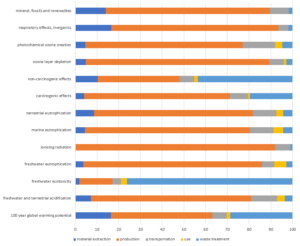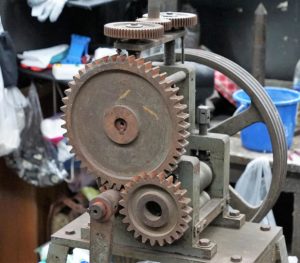56 Practice Exercises
Exercise: Waste Management Hierarchy
British artist Damien Hirst has a series of artwork of well-preserved animal corpses suspended in formaldehyde to express the concepts of life and the inevitable death at the end of it. Recent research shows that the artwork has a risk of leaking formaldehyde, a toxic and carcinogenic compound, during the exhibition.
Based on the concept of waste management hierarchy, what is the most effective way to prevent the leak of formaldehyde? Rank the following actions from the most to least effective?
a) Perform regular maintenance to make sure the container is sealed
b) Place activated carbon around the container to absorb the leaked formaldehyde
c) Use another method to preserve the animals that do not involve the use of toxic substances
d) Provide personal protective equipment for visitors
e) Warn people about the risk before visiting but do not implement any safety measurements
Solution
c, a, b, d, e
c – the production of formaldehyde is eliminated from the source
a – the production of formaldehyde fume is eliminated, but toxic material is still used, and there is still a risk of the leak of toxic materials
b – activated carbon will reduce the effect but not totally eliminate it
d – reduced the health effect to the visitors, but formaldehyde is released into the environment
e – formaldehyde is directly released into the environment
Exercise: Life Cycle Analysis

The graph above shows the life cycle analysis of paper cups. Use the graph to answer the following questions:
a) If we want to improve the life cycle of paper by focusing on reducing inorganics causing respiratory effects, which stage of the life cycle should we focus on?
b) If we want to compare the total mass of freshwater eutrophication substances with terrestrial eutrophication substances, can we get the information using the graph? Why?
Solution
a) production stage
Find the part of the graph investigating “respiratory effects, inorganics”:
![]() The relative lengths of the bars represent the contribution from each life stage. We can see that the bar representing the production stage is much longer than all the other stages. This means that the production stage is emitting a lot more inorganics that result in negative respiratory effects. Therefore, focusing on improving the production stage will be the most effective in terms of eliminating inorganics causing respiratory effects.
The relative lengths of the bars represent the contribution from each life stage. We can see that the bar representing the production stage is much longer than all the other stages. This means that the production stage is emitting a lot more inorganics that result in negative respiratory effects. Therefore, focusing on improving the production stage will be the most effective in terms of eliminating inorganics causing respiratory effects.
For b), it is not possible to compare the total mass of types of hazardous substance emissions using this diagram. In this diagram, each category is scaled to 100% without stating the total overall impact.
Exercise: Environmentally Hazardous Chemicals
DEHP(2-Ethylhexyl phthalate), [latex]C_{10}H_{21}Cl[/latex], and lead are 3 types of environmentally hazardous chemicals released by the soft plastic that we use in daily life. The data is calculated using the EPI Suite software:
| Property | DEHP | [latex]C_{10}H_{21}Cl[/latex] | Lead |
|---|---|---|---|
| Boiling point (°C) | 384 | 223.4 | 485.37 |
| [latex]log_{10}[/latex] of octanol/water partition coefficient | 7.60 | 5.51 | 0.73 |
| Water solubility(mg/L) | 0.27 | 1.133 | 9581 |
| Henry’s law coefficient in water (atm·m3/mol) | [latex]2.70×10^{-7}[/latex] | [latex]1.05×10^{-1}[/latex] | [latex]2.45×10^{-2}[/latex] |
| [latex]log_{10}[/latex] of soil adsorption coefficient | 5.078 | 3.422 | 1.121 |
Say a mixture of these three substances is accidentally released into the soil with some groundwater. Based on the physical property data:
a) Which substance is the most likely to be transported in the groundwater?
b) Which substance is the most likely to contaminate the soil?
c) Say each of these substances is present in a wastewater stream at a steel manufacturing plant in equal concentrations. We are to try to remove these substances by contacting them with a non-polar solvent that has similar properties to n-octanol (and leaving this for sufficient time). Which substance will have the lowest concentration in the wastewater stream after this contact?
Solution
a) Lead is the most likely to be transported into the water due to its high solubility, especially when comparing it to the other two substances.
b) DEHP is the most likely to contaminate the soil because it has the highest soil adsorption coefficient.
c) DEHP will have the lowest concentration after the removal process because it has the highest [latex]log_{10}(K_{ow})[/latex] value.
Exercise: Product Life Stages
Recall the stages in a product’s life: material extraction, processing, component fabrication, product assembly, packaging and distribution, use, and end of use processing. Consider the following images. For each image, identify the life-cycle stage to which it belongs to.
a)
b) 
c) 
d)
Solution
a) Use – the coffee cups are being used by the consumers.
b) Material extraction – trees are cut down and the wood (raw material) is extracted. This wood can be used for a wide range of products, such as paper.
c) Product assembly – a car is being assembled from its individual parts.
d) Component fabrication – Geers are components of multiple products. The image depicts their fabrication.


Feedback/Errata